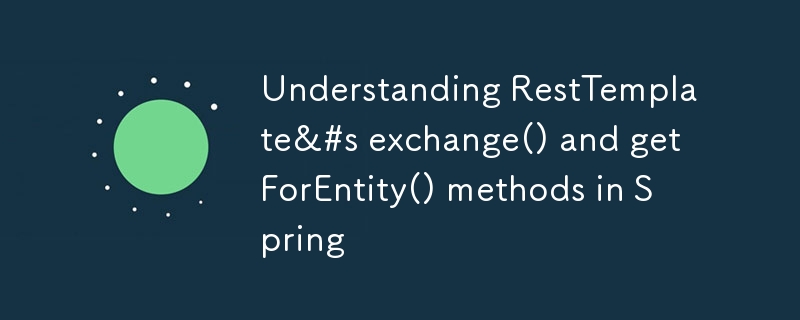

In the world of Java web development, consuming RESTful services is a common requirement. Spring Framework provides a powerful tool calledRestTemplate, which simplifies the process of making HTTP requests. Among its various methods,exchange()andgetForEntity()are two of the most frequently used. In this article, we will explore the differences between these two methods, when to use each, and provide practical examples to illustrate their usage.
RestTemplate is a synchronous client provided by Spring for making HTTP requests. It abstracts the complexities of HTTP communication and allows developers to interact with RESTful services seamlessly. With RestTemplate, you can perform a variety of operations such as GET, POST, PUT, and DELETE requests, making it a versatile choice for web applications.
exchange()
The exchange() method is a more general-purpose method that can handle all HTTP methods (GET, POST, PUT, DELETE, etc.). It allows you to specify the HTTP method you want to use, along with a request entity that can include headers and a request body. This flexibility makes exchange() suitable for a wide range of scenarios.
Key Features:
getForEntity()
In contrast, getForEntity() is specifically designed for making GET requests. It simplifies the process of retrieving resources from a RESTful service without the need for additional configurations. This method is straightforward and ideal for scenarios where you only need to fetch data.
Key Features:
Use exchange() When:
Use getForEntity() When:
import org.springframework.http.HttpEntity; import org.springframework.http.HttpHeaders; import org.springframework.http.HttpMethod; import org.springframework.http.ResponseEntity; import org.springframework.web.client.RestTemplate; public class Example { public static void main(String[] args) { RestTemplate restTemplate = new RestTemplate(); HttpHeaders headers = new HttpHeaders(); headers.set("Authorization", "Bearer your_token_here"); HttpEntity entity = new HttpEntity<>(headers); ResponseEntity response = restTemplate.exchange( "https://api.example.com/resource", HttpMethod.GET, entity, MyResponseType.class ); System.out.println(response.getBody()); } }
import org.springframework.http.ResponseEntity; import org.springframework.web.client.RestTemplate; public class Example { public static void main(String[] args) { RestTemplate restTemplate = new RestTemplate(); ResponseEntity response = restTemplate.getForEntity( "https://api.example.com/resource", MyResponseType.class ); System.out.println(response.getBody()); } }
In conclusion, both exchange() and getForEntity() methods in RestTemplate serve distinct purposes. exchange() offers flexibility for various HTTP methods and customization options, while getForEntity() provides a simple and efficient way to make GET requests. Understanding the differences between these methods will help you choose the right one for your specific use case, making your interactions with RESTful services easier and more efficient.
Happy coding!
Thanks,
Java Charter!
Kailash Nirmal
The above is the detailed content of Understanding RestTemplate&#s exchange() and getForEntity() methods in Spring. For more information, please follow other related articles on the PHP Chinese website!




